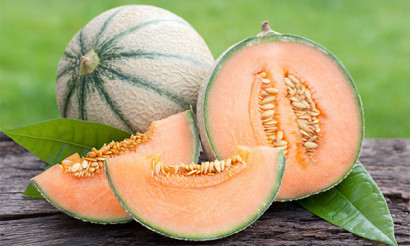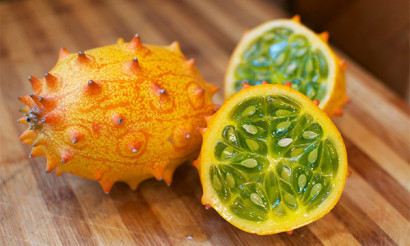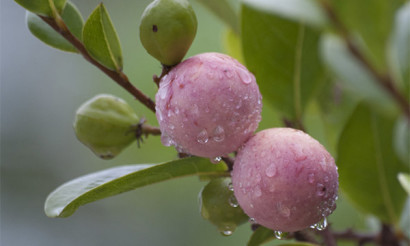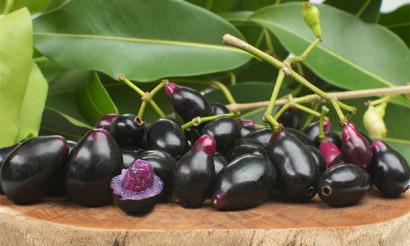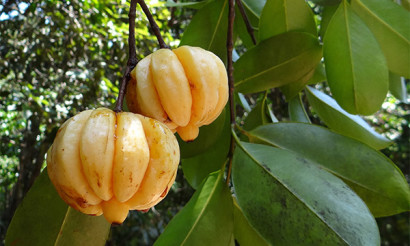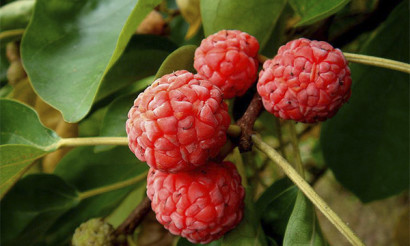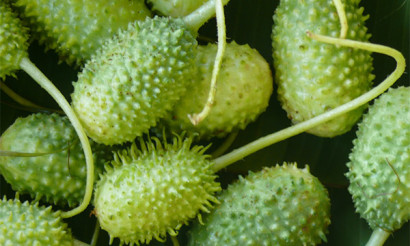Canistel: what kind of fruit is it and how is it healthy
All people perceive the exotic fruit canister differently: as a dessert or as a dish for a full dinner. Some believe that it is suitable for pancakes and muffins, while others perceive it as a side dish for meat.
- What is this fruit
- What does it look like
- Where grows
- What is useful canister
- Which may be harmful
- How to eat fruit canister
- What can be cooked from canister
- Soft drink
- Ice cream with canister
- Custard
- Exotic salad
- Marmalade
- Salad
- Baked Canister
- Application in traditional medicine
- With diabetes
- From anemia
- Stomach ulcer
- From the heat
- Application in cosmetology
- For skin problems
- From pustules
- How to grow
- Interesting Fruit Facts
What is this fruit
A canister is a fruit that grows in the tropics and subtropics. It is characterized by low calorie content and low fat content. You can buy it only in the ripening season, it is very inexpensive. A ripe fruit tastes better than what ripens during the aging process. After eating the fruit, a mealy aftertaste remains in the mouth.

What does it look like
For the tropics, where the canister comes from, this evergreen tree is considered low - it grows up to 8 m. Its bark is brown in color, it is quite sticky because it contains latex. The leaves are shiny, smooth, as if varnished, their length can reach 28 cm, and the width can exceed 7 cm.
The fruit of the tree can be of any shape - from the right round or rounded with a beak bent to the side, to oval or in the form of a spindle. The color of the unripe fruit is green, inside it is hard and sticky, ripe - both outside and inside is yellow or orange. For color, the canister was called egg fruit. In length, it can reach 12–12.5 cm, and in width - almost 7.5 cm. In the middle of the pulp are quite large seeds, their number can range from 1 to 6.
The pulp of ripened fruits, both in appearance and in structure, is similar to a hard-boiled egg, therefore the plant was called “egg fruit”.
The ripened fruits spoil so quickly that it is impossible to transport them either by road or by plane, so you will not meet this exotic guest in Russian supermarkets.
Where grows
You can treat yourself to canister in places of natural growth or cultivation of plants - Southern Mexico, Nicaragua, Costa Rica, El Salvador, Belize, Guatemala, Puerto Rico, South Florida, Panama, as well as on the islands - Jamaica, Cuba and The Bahamas. Canister in the Philippines, Venezuela, Colombia, Seychelles and Hawaii is becoming more widespread.
Soil culture prefers not fertile, but poor. On soils with a sufficiently high humus content, it will grow, but you can’t wait for a rich harvest from such trees.
What is useful canister
The canister is, first of all, fiber, which perfectly cleanses the intestines and normalizes its work: eliminates constipation, improves peristalsis, relieves flatulence, and removes toxins.
- Of the vitamins in the fruit, such as B1 and B2, C, PP, A, carotene are contained, their amount is not very large, with the exception of ascorbic acid (vitamin C), due to which redox processes in the body are regulated, immunity is increased, and digestibility improves gland.
- But by the composition of trace elements, this is a real useful storeroom. First of all, it is rich in potassium, which regulates the functioning of the heart and blood vessels. When it is lacking in the human body, all metabolic processes are disrupted, ulcers appear that affect not only the skin, but also the deeper layers of the tissues, their bleeding increases, and swelling also appears.
- Magnesium in the fruit allows you to get rid of dizziness, muscle cramps, nerve tics, and it also reduces tachycardia.
- Calcium, as you know, is involved in the construction of skeleton bones. Therefore, thanks to this component of the canister, it is possible to strengthen the skeletal system and prevent osteoporosis, prevent tooth decay, and improve the condition of hair and nails.
- Another constituent of the fruit is phosphorus, which is actively involved in protein metabolism and the synthesis of enzymes and is extremely necessary for children, because when it is lacking, their mental and physical development is inhibited.
- In addition, the fetus has a complex of amino acids - this is lysine, tryptophani methionine. They participate in a number of life processes - from metabolism to supporting immunity and the formation of muscle mass.
Which may be harmful
The pulp of the canister is very balanced and generally can not harm the body - even if a person has any chronic digestive diseases. Unless, of course, do not overdo it and do not overeat too fruit.
You should not eat a canister for people who show individual intolerance to both the fetus as a whole and its individual ingredients. The fetus is also not recommended for patients suffering from diabetes mellitus and various disorders in the functioning of the pancreas, as well as for children under five years of age - it will be a heavy burden for their digestive system.
If a person is not used to eating this exotic fruit, overeating can cause vomiting, pain in the stomach and “under the spoon”.
How to eat fruit canister
It is necessary to choose a canister ripe, as it is immature sticky and tasteless. The ripened fruit is soft, sunny yellow. Its skin is thin, but inedible, breaking the fruit of the plant into pieces is not difficult. You can cut it with a knife in half.
The pulp can simply be eaten or taken out with a spoon. Residents of Asian countries add or pepper the pulp, pour sauces or dip in them, mix with lemon or lime juice. The indigenous people of the Philippines water the canister with the sweet-sour juice of a tangerine-lime hybrid called kalamansi.
What can be cooked from canister
From the pulp of the canister, jam, marmalade is prepared, fruit is added to the dough for pancakes, cake. In pureed form, it is put in ice cream, used to make a cocktail.
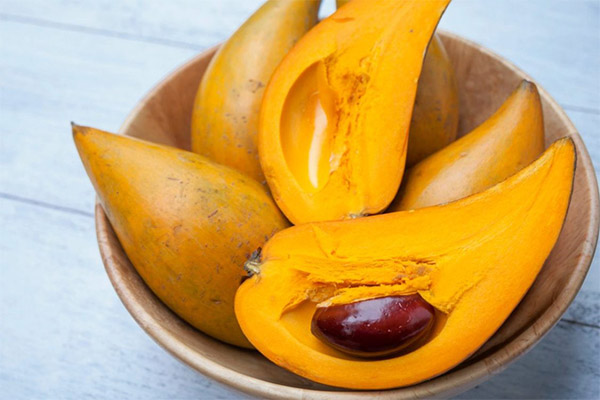
In countries where this exotic fruit comes from, it is eaten with salt and mayonnaise, and with the addition of lime juice, it serves as the basis for soups or salads.
For culinary purposes, you can use absolutely ripened fruits, their peel should be orange or yellow.
Soft drink
Mix in a blender half sliced canister, 0.5 cups of milk, a teaspoon of sugar and a little cinnamon. Add ice cubes.
Ice cream with canister
With one bowl with a ball of ice cream or ice cream, the canister will look nice and taste interesting. Ice cream is better to choose not very sweet. Cut the pulp of the fruit into medium-sized cubes - as for a salad, add lemon juice to the mixture to infuse. After 30-40 minutes, fill the ice cream with juice with a canister and add a pinch of vanilla.
Custard
Cut the pulp of half the canister into small cubes and sprinkle with lime juice. Beat 2 chicken eggs with 30 g of powdered sugar in a strong foam, add 2 tablespoons of cornmeal. Heat a half cup of cream with a fat content of 10%, but do not boil. Place the dish with cream in a water bath and add a little beaten eggs, with a spoon, with constant vigorous stirring. Cook the cream until it thickens, the liquid should evaporate by a quarter.
Grease the silicone molds for the cupcakes with butter, put the chopped canister in them, and the cooked cream on top of it.Put the mold in the oven for 15 minutes, heated to 160-180 degrees. After a quarter of an hour, remove the finished dessert from the oven, sprinkle with nuts. Instead of the oven, you can remove the forms for 5 minutes in a microwave tuned to a temperature of 800W.
Exotic salad
Cut 1 kg of canister pulp into cubes, a dozen pieces of cherry tomatoes - into quarters. Add sliced either sweet pepper or orange - optional. Stir the vegetables in a bowl.
In a separate bowl, mix a glass of olive oil, half a glass of orange and lime juice, as well as 3 tablespoons of maple syrup. Season the chopped vegetables with the resulting sauce.
Marmalade
Take 4 very ripe canisters, peel, remove the seeds and, cut into cubes, put in a spacious dousing pan, pour a glass of sugar and pour the same volume of water. Put on the fire and cook until the pieces of pulp almost completely fall apart, and the marmalade is almost thickened. Pour lime or lemon juice into the prepared mass to taste, decompose it in silicone forms, cool to a warm state, then put in the refrigerator.
Salad
The canister goes well with persimmon, and based on these two fruits you can prepare refreshing interesting salads. For example, peel one fruit, cut it into cubes, persimmon, boiled chicken or turkey fillet, avocado pulp. Add red onion, chopped in half rings. Mix all the ingredients and put on a dish where lettuce or spinach leaves are fan-shaped. Prepare dressing in a separate bowl - mix soy sauce with salt and pepper. Pour salad dressing.
Baked Canister
Cut the fruit into slices, sprinkle with lemon juice and grill. As a result, the mealy aftertaste will disappear, and the finished canister will suit well as a side dish to the hot meat or meat salad.
Application in traditional medicine
With diabetes
Since the canister contains a significant amount of niacin (vitamin B3), which contributes to the better absorption of drugs that lower blood sugar, it can be used in the complex treatment of diabetes.
To do this, grind the pulp of the fruit in a blender, add lemon juice and take at least three times a day - at least 2 tablespoons at a time.
From anemia
Pour boiled water (2 cups) with boiled water and chopped raw or dried canister fruit and send to a water bath for 25-30 minutes. After cooling down, drink the resulting broth during the day, breaking into 3 servings. This tool improves hemopoiesis, relieves headaches and chronic fatigue associated with anemia.
Stomach ulcer
With this tool, residents of Asian countries get rid of stomach ulcers or erosive gastritis. Grate the flesh of the plant with the seeds either in a food processor or with a blender. The resulting slurry is eaten in a tablespoon three times a day after meals.
From the heat
Take a tablespoon of crushed bark of the canister tree. Pour it with 300 ml of water and boil for 10-15 minutes. Cool, filter, drink 120-150 ml, if the temperature rises. This tool is actively used in Mexico. In addition to the antipyretic effect, the decoction increases the immunity of a patient with acute respiratory viral infections.
Application in cosmetology
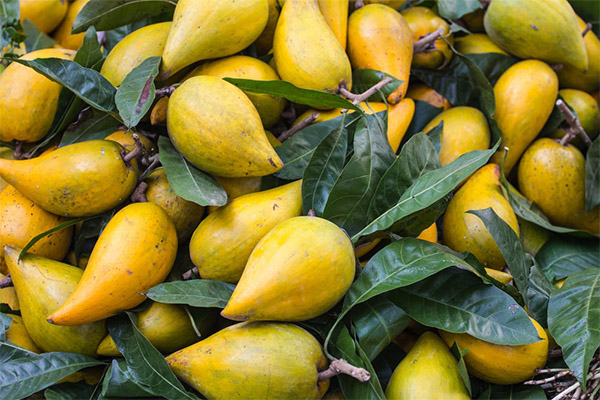
For skin problems
Grind a tablespoon of canister bark and boil it for a quarter of an hour in 300 ml of water. Cool, filter and make lotions with redness and irritation of the skin. This tool is used in Cuba.
From pustules
Using a blender, grind the pulp of the fruit, squeeze the juice using gauze folded into several layers. Juice treat purulent-inflammatory processes - such as long-healing boils, abscesses, trophic ulcers and various dermatological diseases.
How to grow
It is difficult to grow a canister at home, but true gardening fans do it. The main thing is that the planting material is good. Since the seeds very quickly lose their viability, they need to be planted literally within the next few days after the fruit is eaten.

Seeds germinate usually in 2 weeks. But if during this time the seedlings did not appear, you should not despair - there is also a delay. Sometimes, up to the time of germination, it may take almost 5 months. But the gimp compensates for such a slow pace by the rapid and friendly growth of seedlings. They enter the fruiting phase in the third to sixth year.
In the southern regions of Russia, the tree can grow even in open ground, it is not afraid of small frosts and tolerates wind and drought.
At home, the plant will need a large pot (at least 20 liters), and even better - a tub. He needs sandy or sandy loamy soil, and limestones are quite suitable. Botany established a pattern - the poorer the soil, the higher the tree yield. So he does not need additional fertilizing. The main thing is to keep it warm. In summer, in hot weather, it can be taken out to the balcony or outdoor terrace. In winter, protect from dry air, for which either daily spray the leaves with water, or put a humidifier nearby.
Interesting Fruit Facts
- The canister spoils rather quickly and in a week after harvesting it may turn out to be unsuitable for consumption. Therefore, if there is a desire to use fruit after cooking, it makes sense to buy its pulp in slices, it is easier to see its quality.
- When cutting the canister, there is not a sweetish fresh smell, as is usually the case with fruits, but a distinct aroma of fried pies with meat or whitewash. By the way, it is not inferior in nutritional value to whites. It seems to some that the fruit of this plant smells like a school cafeteria.
- Residents of countries where canister grows, consider it not a fruit, but a vegetable, therefore they like to stew it, bake it, generously seasoning it with various spices.
- The canister is cultivated not only for food use. Of particular value is its wood - durable, resistant to decay. Local residents use it as piles and make rafters and furniture from it. And since the core of the trunk is also highly decorative, it is used for souvenirs and as a finishing material.
«Important: all information on the site is provided exclusively in fact-finding purposes. Before applying any recommendations, consult with a profile specialist. Neither the editors nor the authors are liable for any possible harm caused materials. "

